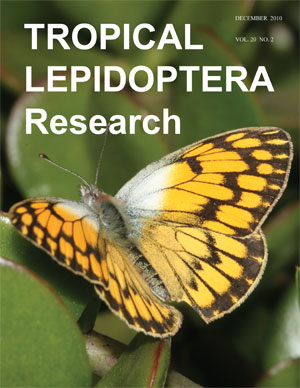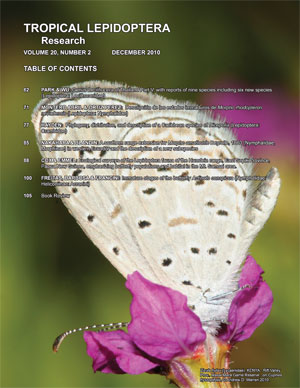

TROPICAL LEPIDOPTERA Research


62 PARK & WU: Genus Lecithocera of Thailand Part V, with reports of nine species including six new species (Lepidoptera: Lecithoceridae)
Abstract - As the 5th part of the serial studies on the genus Lecithocera Herrich-Schäffer of Thailand, nine additional species including six new species: L. gilviana sp. nov., L. orbiculata sp. nov., L. tumidosa sp. nov., L. calomerida sp. nov., L. poculata sp. nov., and L. eremiodes sp. nov., are reported in this paper. Three species, L. mylitacha Herrich-Schäffer, L. castanoma Wu, and L. squalida Gozmány, are first reported from Thailand, and the females of them are newly found since the species were described. Images of adults, venation, and the male and female genitalia of the known species are given.
Key words: Taxonomy, Lecithocera, Lecithocerinae, Gelechioidea, morphology, description.
71 MONTERO ABRIL & ORTIZ PEREZ: Descripción de los estados immaduros de Morpho rhodopteron nevadensis (Lepidoptera: Nymphalidae)
Resumen - Se describe por primera vez el ciclo de vida de Morpho rhodopteron (Godman & Salvin, 1880) especie endémica de la Sierra Nevada de Santa
Marta – Colombia. Este presenta una duración total promedio de 199 días desde el momento de la ovoposición hasta la emergencia de los adultos, figurando hasta el momento como el es uno de los ciclos biologicos mas prolongados para los Rhopalocera del Neotropico. La especie está asociada al hospedero Chusquea sp. (Poaceae). Aspectos relacionados con el comportamiento de las larvas como uso de la planta hospedero, actividad nocturna, utilización de las glándulas de acicalamiento, entre otros, son discutidos. Se hace una comparación del ciclo biológico con la especie Morpho sulkowskyi, siendo esta la especie más cercana filogenéticamente en Colombia. Se reportan datos de los adultos en el medio natural.
Palabras Clave: Morpho rhodopteron, Ciclo de vida, Endemismo, larvas, Chusque, Colombia, Sierra Nevada de Santa Marta, Conservación.
Abstract - The life cycle of Morpho rhodopteron (Godman & Salvin, 1880), a species endemic to the Sierra Nevada de Santa Marta, Colombia, is described for the first time. The species has an average development time of 199 days from oviposition to adult emergence, constituting one of the longest life cycles yet described for any Neotropical butterfly. The species feeds on Chusquea sp. (Poaceae). Larval behavior is described, including hostplant use, nocturnal activity, and use of grooming glands. The life cycle duration is compared with that of Morpho sulkowskyi, the most closely related species in Colombia. Observations are reported for the adults in the natural habitat.
Key words: Chusque, Colombia, conservation, endemism, larva, life cycle, Morpho rhodopteron, Sierra Nevada de Santa Marta.
77 Hayden: Phylogeny, distribution, and description of a Caribbean species of Dicepolia (Lepidoptera: Crambidae)
Abstract- Dicepolia nigritinctalis sp. nov. is described from two female specimens from eastern Cuba and Chiapas, Mexico. The new species is most closely related to D. rufitinctalis (Hampson) or D. aerealis Hayden and occurs on the northern periphery of the range of the genus. Significant range extensions are reported for other species of Dicepolia Snellen across central and southern Brazil. A phylogenetic analysis of Dicepolia with 36 morphological characters, including two quantitative characters, indicates monophyly of the Malagasy and Neotropical groups and within the latter, monophyly of the small- and largebodied species groups.
Key words: Neotropics, distribution, phylogeny, continuous data
85 Nakahara & Blandin: A southern range extension for Morpho amathonte Deyrolle, 1860 (Nymphalidae, Morphinae) in western Ecuador and the description of a new subspecies
Abstract- We report here a record of Morpho amathonte from La Troncal, Cañar, in western Ecuador, representing the southernmost known locality for
the species in the country. The Cañar specimens are phenotypically different to those from north-western Ecuador, which are known as Morpho amathonte ecuadorensis Le Moult and Réal, 1962. We therefore describe a new subspecies, Morpho amathonte canyarensis ssp. nov., for the Cañar population.
88 Cox & Emmel: Ecological surveys of the Lepidoptera fauna of the Hunstein range, East Sepik Province, Papua New Guinea, emphasizing butterfly populations and habitat in the Mt. Samsai area.
Abstract- Starting with a preliminary survey of Lepidoptera species in March 1998 in the Hunstein Range of Papua New Guinea, a more intensive community-interactive research project was developed in collaboration with two national PNG government agencies and the University of Papua New Guinea. The first phase was carried out during October 2003 with an expedition to the west slope approach to Mt. Samsai, the highest peak (at 1525 m) in the remote Hunstein Range of southern East Sepik Province. More than 111 butterfly taxa were recorded during the 9-22 October 2003 expedition. Habitats and unusual taxa encountered are discussed and illustrated.
Key words: Faunistic survey, biodiversity, local community, sustainable use of resources, conservation.
100 Freitas, Barbosa & Francini: Immature stages of the butterfly Actinote conspicua (Nymphalidae: Heliconiinae: Acraeini)
Abstract – The early stages, food plant and behavior of Actinote conspicua Jordan, 1913, are described from Campos do Jordão, São Paulo, Brazil. Immature stage morphological characters are compared to those of other Actinote species.
Resumo – Os estágios imaturos, a planta hospedeira e o comportamento de Actinote conspicua Jordan, 1913, foram descritos de material proveniente de
Campos do Jordão, São Paulo, Brazil. Os caracteres morfológicos dos imaturos foram comparados àqueles encontrados em outras espécies de Actinote.
Key words: Acraeini, Actinote, Actinote conspicua, life-cycle, Nymphalidae
105 Book Review